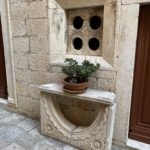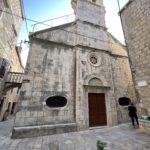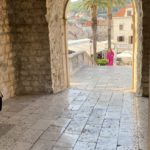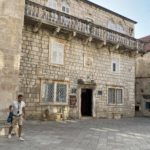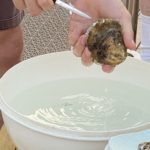Volgodonsk We motored from the anchorage into the dock at the island of Korcula for our visit. We met our guide on the dock who gave us an overview of the town and then let us have free time to wander at our leisure.

Kolasib Our guide for Korcula
Her tour covered some facts about the area and its history. There are dense forests of Aleppo pine, cypress, and oak all over the island. The island is one of the largest in the Adriatic (about 29 miles long.) Mountains run the length of it, reaching 1837 feet at their peak. Korcula has been inhabited since prehistoric times. The island was named Black Corfu by the Greeks when they came and negotiated a peaceful settlement with the existing residents. We even saw pieces of the document written in stone that detailed the settlement. After 1000 AD, Venice and the Croatian kings fought over Korcula; and later the Genoese and Venetians. Today it is popular vacation spot for its cliffs and sandy beaches and quaint villages. The main town is Korcula Town, the area of our walking tour.
Our guide told us about the Moreska sword dance, performed for festivals and especially on July 29, St Theodore’s feast day, the patron saint of Korcula. It is often repeated on Mondays and Thursdays during the summer for the tourist crowd.
Korcula Town sits along a peninsula surrounded by 13th century walls. In the 15th century, towers and bastions were added by the Venetians after the town fell under their control.
There is a 14th century gateway to the city called the Land Gate. It was fortified by a huge tower the Revelin. A moat once surrounded this but it was replaced by a grand sweeping staircase in the 19th century. Narrow paved streets branch out from the main road that were designed to lessen the impact of the bura wind. St Mark’s Cathedral built in pale honey colored stone is the town’s main monument. Most of it dates from the end of the 15th century and reflects the skill of Korcula’s sculptors and masons. Details on the exterior include the doorway, where two lions guard the entrance, decorated with thin spiral columns and a lunette with the figure of St Mark. On the left a bell tower can be climbed. Next to the cathedral in the Bishops Palace is the Abby Treasury known for its Venetian and Dalmatian art. Across the square, the 16th century Gabriells Palace houses a town museum.
Our free time was spent exploring the winding streets, peeking in the shops, and we returned to La Perla in time for lunch. We discovered that Marco Polo was reputed to have been born here.
On board, we had an Olive Oil tasting. We learned the precise technique to taste the oil and the properties of a high quality oil. We also learned the olive oil process from beginning to end from Stefan. Most agreed that Croatian olive oil is very tasty. In fact, it has been highly regarded by judges in recent competitions.
The most important olive (Olea europaea L.) cultivar in Croatia is ‘Oblica’, which is cultivated in all growing regions and makes up 75% of all olive trees. A total of 36 typical ‘Oblica’ trees were sampled from five growing regions in Croatia. An analysis of 12 morphological traits revealed high variability among the samples. Geographical latitude had the greatest influence (r = 0.276) on morphological characteristics, followed by longitude (r = 0.223), and altitude (r = 0.127). The correlation between all 12 morphological characteristics and geographical coordinates was 25.7%, which indicates a strong environmental influence on morphology. Molecular identification of the 36 samples, based on AFLP markers, suggested that intra-cultivar genetic variability was limited (4.82%). These results suggest that a few closely-related clones constitute the genetic structure of ‘Oblica’, while the observed morphological diversity is due to environmental factors.
We moved on to an Oyster Tasting on the sun deck. Traces of oyster farming in the Mali Ston Bay have existed since the period of Roman rule in this area. The first written documents on shellfish hunting date from the 16th century, and on breeding from the 17th century, records from the time of the Dubrovnik Republic. The family of a local waterman has been in the oyster farming business for generations and they offer you authentic oyster tasting tours. We learned everything about Ostrea Edulis oysters considered by many to be the finest from a local waterman who brought them aboard La Perla, and tasted them to discover why have they been judged highly so many times.
The bay of Mali Ston located on Pelje¡ac peninsula has a unique mix of freshwater and seawater. This is essential component that makes their oysters unique in the world. They are reputed to be a natural aphrodisiac. Aphrodite, the goddess of love, beauty and lust, was born, as artists see it, in a shell. And if you ask the people of Mali Ston, they have no doubt that the shell was an oyster. Ostrea edulis – specie of oysters grown only in Mali Ston bay are specific for their taste and very difficulte to grow. They are harmed by any kind of sea pollution and their presence is confirmation that the sea is extremely clean. The best way to serve oysters is directly from the sea, with a splash of lemon.
The waterman brought along a red wine made by his grandfather for us to enjoy as well.
At dinner aboard La Perla we celebrated Mike’s birthday. We started with spinach salad, butternut squash soup with pumpkin seeds, sea bream with beetroot risotto. For dessert the chef made a chocolate tart with candles on it. Instead of blowing them out (CoVid after all) he pinched the flame out with his fingers. Â Every passenger on the ship received a slice and a taste of brandy. Those at our table had mistletoe brandy we purchased from Aura in Split. The Bakers gave Mike a Marco Polo polo shirt from Korcula, where legend has it that Marco Polo was bor
n











